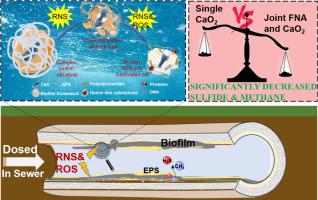当前位置:
X-MOL 学术
›
Chem. Eng. J.
›
论文详情
Our official English website, www.x-mol.net, welcomes your feedback! (Note: you will need to create a separate account there.)
Enhancing sulfide and methane control in sewers: Unveiling the impact and mechanisms of free nitrous acid pre-exposure coupled with calcium peroxide dosing
Chemical Engineering Journal ( IF 13.3 ) Pub Date : 2024-06-28 , DOI: 10.1016/j.cej.2024.153576 Haixiao Guo , Suwan Dai , Yiming Li , Hui Wang , Jiaqi Hou , Yanying He , Yufen Wang , Tingting Zhu , Peizhe Sun , Bing-Jie Ni , Yiwen Liu
Chemical Engineering Journal ( IF 13.3 ) Pub Date : 2024-06-28 , DOI: 10.1016/j.cej.2024.153576 Haixiao Guo , Suwan Dai , Yiming Li , Hui Wang , Jiaqi Hou , Yanying He , Yufen Wang , Tingting Zhu , Peizhe Sun , Bing-Jie Ni , Yiwen Liu

|
Although biocides have proven highly efficient in controlling hazardous emissions and mitigating organic carbon loss in sewers, the resistance of biofilm and extracellular polymeric substances (EPS) to biocides has emerged as a significant impediment to addressing these challenges. In this study, a promising strategy of calcium peroxide (CaO) dosing assisted by free nitrous acid (FNA) pre-exposure overcame these limitations. Prior to a 6-hour exposure to 0.1 % (w/v) CaO, a 2-hour pre-exposure to a low dose of 0.26 mg-N/L FNA demonstrated a significant enhancement in sulfide and methane control efficiency by 267.14 % and 390.47 %, respectively, compared to direct exposure to 0.2 % CaO for 12 h. Moreover, there was a notable increase of 40.05 % in soluble COD level in the effluent. FT-IR and XPS analyses discovered the disruption, migration, and dissolution of biofilm, accompanied by a substantial increase in membrane permeability (up to 2.89 folds). Additional analysis revealed that the synergistic effects of various reactive nitrogen/oxygen species destabilized the structure of EPS, e.g., declining total EPS yield, disintegrating humic acid-like and tryptophan- and protein-like substances, reducing hydrogen bond in β-sheet of proteins. Further down-regulation of node genes associated with sulfidogenesis and methanogenesis verified the toxic mechanism at the genetic level. Microbial community analysis revealed a significant reduction in the abundance of sulfate-reducing bacteria and methanogenic archaea, leading to an extended recovery period for sulfide and methane production in sewer biofilm. This study provides an effective strategy and in-depth mechanisms for biofilm control, applicable beyond sewer biofilm.
中文翻译:

加强下水道中硫化物和甲烷的控制:揭示游离亚硝酸预暴露与过氧化钙剂量相结合的影响和机制
尽管杀菌剂已被证明在控制有害排放和减轻下水道中有机碳损失方面非常有效,但生物膜和细胞外聚合物(EPS)对杀菌剂的抵抗力已成为解决这些挑战的重大障碍。在这项研究中,一种有前景的过氧化钙(CaO)剂量辅助游离亚硝酸(FNA)预暴露策略克服了这些局限性。在暴露于 0.1% (w/v) CaO 6 小时之前,预暴露于低剂量 0.26 mg-N/L FNA 2 小时表明硫化物和甲烷控制效率显着增强 267.14%,与直接暴露于 0.2% CaO 12 小时相比,分别为 390.47%。此外,废水中可溶性 COD 水平显着增加了 40.05%。 FT-IR 和 XPS 分析发现生物膜发生破坏、迁移和溶解,同时膜渗透性大幅增加(高达 2.89 倍)。进一步的分析表明,各种活性氮/氧的协同作用破坏了 EPS 结构的稳定性,例如,EPS 总产量下降,腐殖酸类、色氨酸类和蛋白质类物质分解,蛋白质 β-折叠中的氢键减少。与硫化物生成和产甲烷作用相关的节点基因的进一步下调在基因水平上验证了毒性机制。微生物群落分析显示硫酸盐还原菌和产甲烷古菌的丰度显着减少,导致下水道生物膜中硫化物和甲烷生产的恢复期延长。这项研究为生物膜控制提供了有效的策略和深入的机制,适用于下水道生物膜之外的领域。
更新日期:2024-06-28
中文翻译:

加强下水道中硫化物和甲烷的控制:揭示游离亚硝酸预暴露与过氧化钙剂量相结合的影响和机制
尽管杀菌剂已被证明在控制有害排放和减轻下水道中有机碳损失方面非常有效,但生物膜和细胞外聚合物(EPS)对杀菌剂的抵抗力已成为解决这些挑战的重大障碍。在这项研究中,一种有前景的过氧化钙(CaO)剂量辅助游离亚硝酸(FNA)预暴露策略克服了这些局限性。在暴露于 0.1% (w/v) CaO 6 小时之前,预暴露于低剂量 0.26 mg-N/L FNA 2 小时表明硫化物和甲烷控制效率显着增强 267.14%,与直接暴露于 0.2% CaO 12 小时相比,分别为 390.47%。此外,废水中可溶性 COD 水平显着增加了 40.05%。 FT-IR 和 XPS 分析发现生物膜发生破坏、迁移和溶解,同时膜渗透性大幅增加(高达 2.89 倍)。进一步的分析表明,各种活性氮/氧的协同作用破坏了 EPS 结构的稳定性,例如,EPS 总产量下降,腐殖酸类、色氨酸类和蛋白质类物质分解,蛋白质 β-折叠中的氢键减少。与硫化物生成和产甲烷作用相关的节点基因的进一步下调在基因水平上验证了毒性机制。微生物群落分析显示硫酸盐还原菌和产甲烷古菌的丰度显着减少,导致下水道生物膜中硫化物和甲烷生产的恢复期延长。这项研究为生物膜控制提供了有效的策略和深入的机制,适用于下水道生物膜之外的领域。






































 京公网安备 11010802027423号
京公网安备 11010802027423号